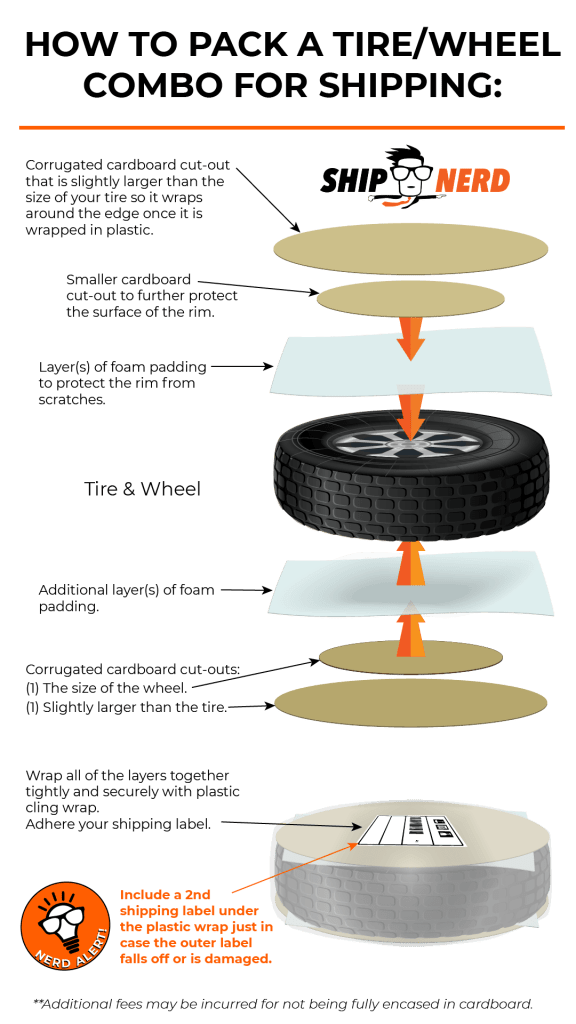Shipping wheels and tires requires careful consideration to ensure they arrive safely and undamaged. The process involves proper packaging, choosing the right shipping carrier, and understanding the various options available. Many people underestimate the importance of secure packaging for these items, leading to potential damage during transit. Therefore, knowing exactly how are wheels and tires shipped correctly is crucial for both businesses and individuals looking to send these valuable components.
Preparing Wheels and Tires for Shipping
Before you even think about selecting a carrier, you need to properly prepare your wheels and tires. This is the most critical step in ensuring their safe arrival.
- Cleaning: Remove all dirt, grime, and debris. A clean surface allows packaging materials to adhere better.
- Individual Wrapping: Wrap each wheel and tire individually with several layers of heavy-duty bubble wrap. Pay special attention to protecting the edges and any protruding parts.
- Cardboard Protection: Cut cardboard pieces to cover the front and back of each wheel and tire. This adds an extra layer of protection against punctures and impacts.
- Securing the Packaging: Use strong packing tape to secure all wrapping and cardboard pieces. Make sure every inch is covered, leaving no exposed areas.
Choosing the Right Shipping Carrier
Selecting the appropriate shipping carrier depends on several factors, including the weight and dimensions of the package, the destination, and your budget. Here’s a breakdown of popular options:
- Major Carriers (UPS, FedEx, DHL): These carriers offer reliable service and tracking capabilities. They are generally a good choice for both domestic and international shipments.
- Freight Carriers: For larger quantities or oversized wheels and tires, freight carriers may be more cost-effective. They specialize in handling heavier and bulkier items.
- Specialized Shipping Services: Some companies specialize in shipping automotive parts, offering tailored solutions for wheels and tires.
Comparison of Shipping Carriers
| Carrier | Pros | Cons | Best For |
|---|---|---|---|
| UPS/FedEx/DHL | Reliable tracking, fast delivery options, wide network | Can be expensive for heavy items | Individual wheels and tires, domestic shipments |
| Freight Carriers | Cost-effective for large quantities, handles oversized items | Slower delivery times, less detailed tracking | Bulk shipments, oversized wheels and tires |
| Specialized Services | Tailored solutions, expertise in automotive parts | Potentially higher costs, limited geographic coverage | High-value wheels and tires, specialized needs |
Understanding Shipping Costs and Insurance
Shipping costs are determined by the weight, dimensions, and destination of the package. It’s essential to get quotes from multiple carriers to compare prices. Always consider purchasing shipping insurance to protect against loss or damage. Insurance provides peace of mind knowing you’ll be compensated if something goes wrong during transit. Understanding these costs is a key component of knowing how are wheels and tires shipped effectively.
Shipping wheels and tires can be a straightforward process when done correctly. By following these steps and taking the necessary precautions, you can ensure that your wheels and tires arrive safely and in excellent condition. Remember, the key to successful shipping lies in proper packaging, careful carrier selection, and understanding the associated costs.
TRACKING YOUR SHIPMENT AND HANDLING POTENTIAL ISSUES
Once your wheels and tires are en route, closely monitor the tracking information provided by the carrier. This allows you to anticipate potential delays and address any issues promptly. If you notice any discrepancies or suspect damage, contact the carrier immediately. Document everything, including photos of the packaging before and after shipment, to support any claims you may need to file.
– Regular Tracking: Check the tracking information daily for updates.
– Communication: Stay in contact with the carrier if any delays occur.
– Documentation: Keep records of all communication, tracking information, and photos.
ALTERNATIVE SHIPPING METHODS
While traditional shipping methods are common, there are alternative options that might be suitable depending on your specific needs.
– Local Delivery Services: If you’re shipping locally, consider using a local courier service for potentially faster and more personalized delivery.
– Peer-to-Peer Shipping: Platforms connecting individuals with vehicles traveling in the desired direction can offer cost-effective solutions, but require careful vetting and trust.
– Pallet Shipping: For larger shipments of wheels and tires, consolidating them on a pallet can streamline the process and potentially reduce costs.
WHEN TO CONSIDER ALTERNATIVE SHIPPING
Scenario
Alternative Shipping Method
Benefits
Local Delivery
Local Courier Service
Faster delivery, personalized service
Cost-Sensitive Shipping
Peer-to-Peer Shipping
Potentially lower costs
Large Shipments
Pallet Shipping
Streamlined handling, reduced costs
Ultimately, the best method for how are wheels and tires shipped will depend on your individual circumstances. By understanding the options available and taking the necessary precautions, you can ensure a smooth and successful shipping experience. This includes being prepared to handle unforeseen issues and choosing the method that best aligns with your budget, timeline, and risk tolerance.

